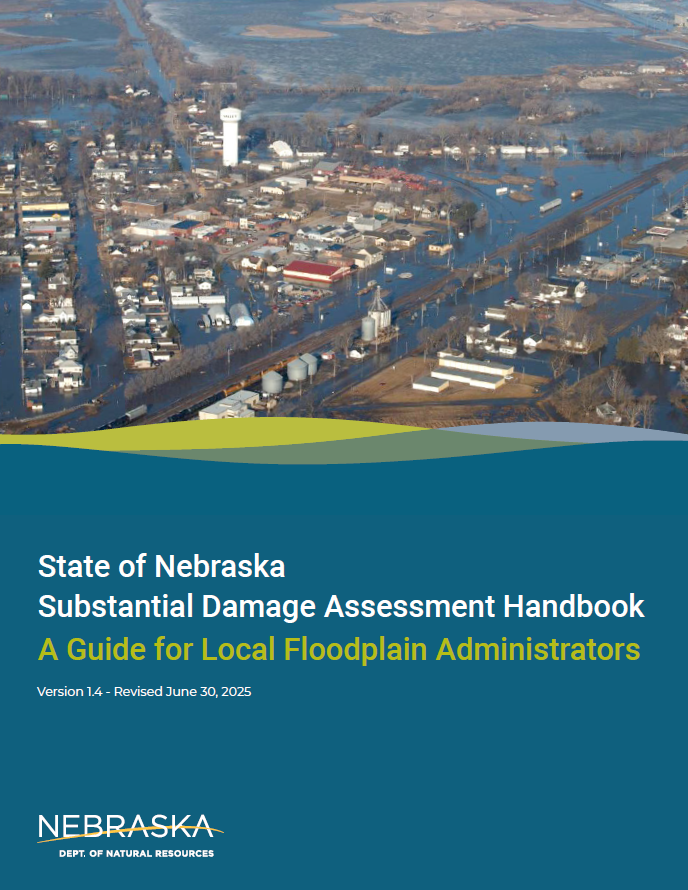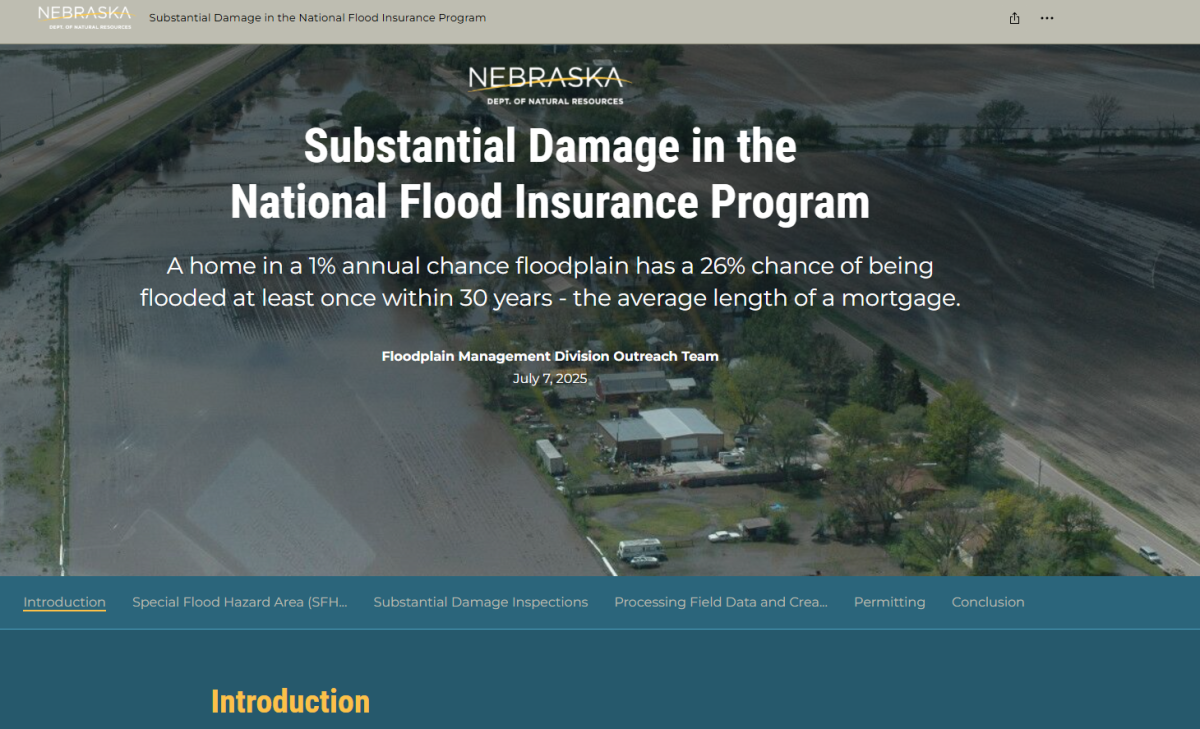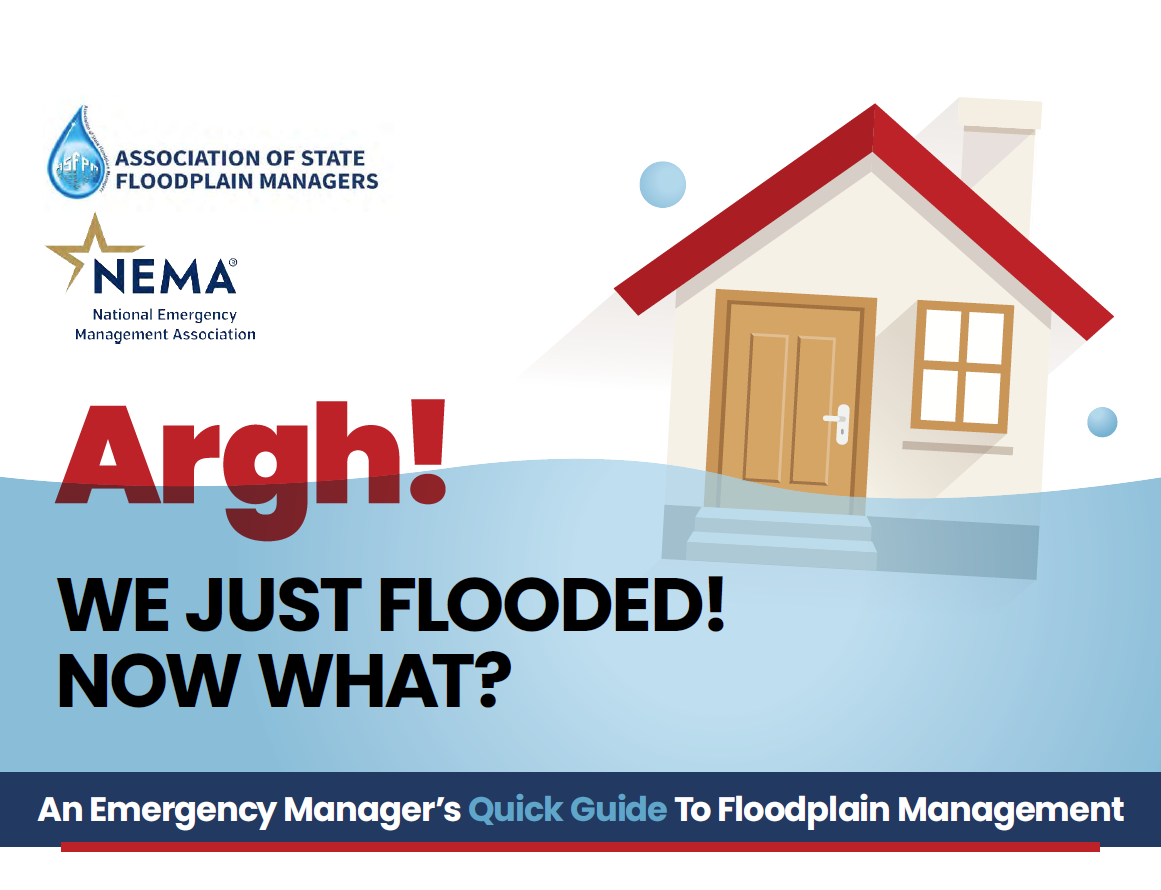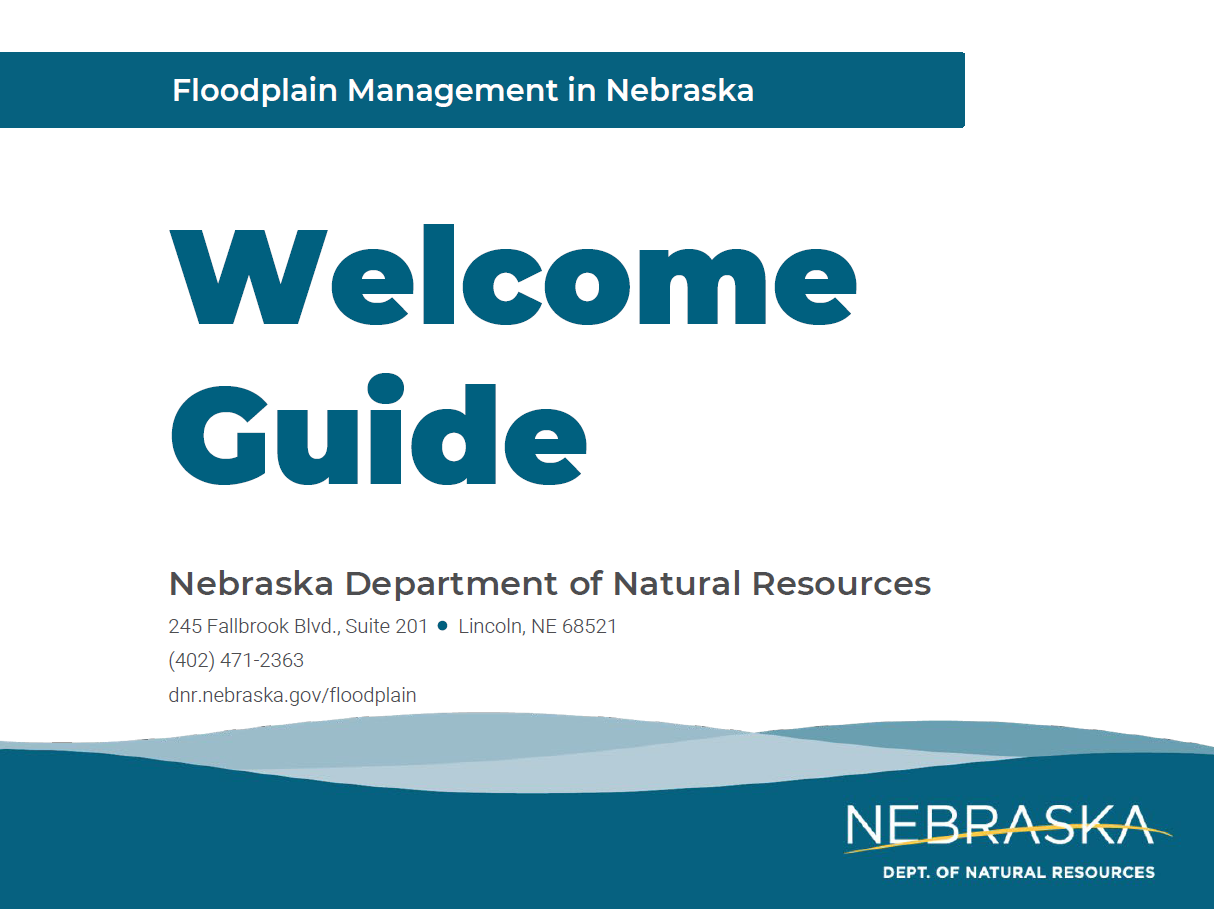Desk Reference/Floodplain Management Resources
Floodplain Development Permitting
2025 Model Structural Floodplain Development Permit
2025 Model Structural Floodplain Development Permit - Fillable PDF
Instructions - Structural Floodplain Development Permit
2025 Model Nonstructural Floodplain Development Permit
2025 Model Nonstructural Floodplain Development Permit - Fillable PDF
Instructions - Nonstructural Floodplain Development Permit
Request for Information (RFI) for Incomplete Permit Application
OLD: NE Model Floodplain Development Permit Application
![]() "No-Rise" Certificate Procedures and Sample Certification
"No-Rise" Certificate Procedures and Sample Certification
Elevation and Dry-floodproofing Certificates
![]() Elevation Certificate - 2023 Edition (Fillable PDF)
Elevation Certificate - 2023 Edition (Fillable PDF)
- May not open directly from your browser. Save the file locally to your computer, then open from your files.
![]() Elevation Certificate - 2023 Edition (Non-fillable PDF)
Elevation Certificate - 2023 Edition (Non-fillable PDF)
![]() Elevation Certificate - 2023 Edition (Instructions)
Elevation Certificate - 2023 Edition (Instructions)
![]() FEMA Elevation Certificate and Floodproofing Certificate Bulletin - 8/9/2023
FEMA Elevation Certificate and Floodproofing Certificate Bulletin - 8/9/2023
![]() Elevation Certificate Correction Form
Elevation Certificate Correction Form
![]() CRS Elevation Certificate Checklist - 2022 Edition
CRS Elevation Certificate Checklist - 2022 Edition![]() Dry Floodproofing Certificate for Non-Residential Structures
Dry Floodproofing Certificate for Non-Residential Structures
Other Forms
![]() Standard Flood Hazard Determination Form
Standard Flood Hazard Determination Form![]() Community Acknowledgement of Requests Involving Fill
Community Acknowledgement of Requests Involving Fill![]() Crawlspace Construction in SFHAs
Crawlspace Construction in SFHAs![]() Residential Basement Floodproofing Certificate (5/31/2020)
Residential Basement Floodproofing Certificate (5/31/2020)![]() Residential Basement Floodproofing Information
Residential Basement Floodproofing Information![]() Lincoln Building Restriction Agreement for LOMR-F Acknowledgement
Lincoln Building Restriction Agreement for LOMR-F Acknowledgement
Nebraska Minimum Standards for Floodplain Management Programs (Title 455)
Every local floodplain management program is supported by a floodplain management ordinance. The ordinance establishes the requirements for development in the identified floodplain. Ordinances must meet the Nebraska Minimum Standards for Floodplain Management Programs as well as the requirements in 44 CFR Chapter 1, Part 60.3. Nebraska's Floodplain Management Division has developed model ordinances that communities can use for a template, provided community staff and boards review it for appropriate inclusion into the broad set of ordinances. All ordinances must be reviewed and approved by NeDNR and FEMA before being adopted.
FEMA 480 Manual, Unit 7: FEMA Ordinance Administration
ASFPM No Adverse Impact: How-to-Guides
ASFPM No Adverse Impact: Elected officials guide to understanding and managing flood risk
Floodplain Management Today:
- "Ugly is Not a Floodplain Violation"
- "Violations and Enforcement Part II: Reaching for the Big Stick"
- "Violations and Enforcement Part III - Big Stick Tools"
![]() NFIP 1316 Declaration or Rescission Review Checklist
NFIP 1316 Declaration or Rescission Review Checklist
![]() Liability For Water Control Structure Failure Due to Flooding
Liability For Water Control Structure Failure Due to Flooding
![]() Legal Questions: Government Liability And No Adverse Impact Floodplain Management
Legal Questions: Government Liability And No Adverse Impact Floodplain Management
![]() Professional Liability for Construction in Flood Hazard Areas
Professional Liability for Construction in Flood Hazard Areas
![]() Public Liability for Flood Hazard Mitigation
Public Liability for Flood Hazard Mitigation
![]() Case: Mansoldo vs NJ Brief Amicus Curiae 2006
Case: Mansoldo vs NJ Brief Amicus Curiae 2006
![]() Case: Mansoldo vs NJ - Syllabus 2006
Case: Mansoldo vs NJ - Syllabus 2006
![]() Case: What the Rapanos - Carabell Wetlands Decisions Mean to Floodplain and Stormwater Managers
Case: What the Rapanos - Carabell Wetlands Decisions Mean to Floodplain and Stormwater Managers
![]() Case Study: Courts Issue Good News for Floodplain Management
Case Study: Courts Issue Good News for Floodplain Management
![]() Common Legal Questions About Floodplain Regulations in the Courts
Common Legal Questions About Floodplain Regulations in the Courts
![]() Mitigating Misery: Land Use and Protection of Property Rights Before the Next Big Flood
Mitigating Misery: Land Use and Protection of Property Rights Before the Next Big Flood
![]() NAI Flyer: Legal Issues for Community Officials
NAI Flyer: Legal Issues for Community Officials
![]() NAI: Floodplain Management and the Courts 2005
NAI: Floodplain Management and the Courts 2005
![]() NAI and the Courts: Protecting The Property Rights of All: No Adverse Impact Floodplain and Stormwater Management
NAI and the Courts: Protecting The Property Rights of All: No Adverse Impact Floodplain and Stormwater Management
![]() Floodplain Management Requirements for Agricultural Structures and Accessory Structures
Floodplain Management Requirements for Agricultural Structures and Accessory Structures
![]() Agricultural and Accessory Structure Policy (2021)
Agricultural and Accessory Structure Policy (2021)
![]() Determination of the Cost of Repair or Reconstruction to Damaged Buildings
Determination of the Cost of Repair or Reconstruction to Damaged Buildings
![]() Questions and Answers about Substantial Damage
Questions and Answers about Substantial Damage
![]() Determining the Lowest Floor
Determining the Lowest Floor
![]() General Principles for Variances
General Principles for Variances
![]() Manufactured Homes in SFHAs
Manufactured Homes in SFHAs
![]() Requirement for "Reasonably Safe from Flooding" for LOMR-F
Requirement for "Reasonably Safe from Flooding" for LOMR-F
![]() The 50% Rule for Substantial Damage or Improvement
The 50% Rule for Substantial Damage or Improvement
![]() Placement of Temporary Structures in the Floodway
Placement of Temporary Structures in the Floodway
![]() Guidance for Unnumbered A Zones
Guidance for Unnumbered A Zones
![]() Technical Bulletin 0 - User's Guide to Technical Bulletins (2021)
Technical Bulletin 0 - User's Guide to Technical Bulletins (2021)
![]() Technical Bulletin 1 - Openings in Foundation Walls (2020)
Technical Bulletin 1 - Openings in Foundation Walls (2020)
![]() Technical Bulletin 2 - Flood-Damage Resistant Materials Requirements
Technical Bulletin 2 - Flood-Damage Resistant Materials Requirements
![]() Technical Bulletin 3 - Non-Residential Floodproofing (2021)
Technical Bulletin 3 - Non-Residential Floodproofing (2021)
![]() Technical Bulletin 4 - Elevator Installation (2019)
Technical Bulletin 4 - Elevator Installation (2019)
![]() Technical Bulletin 5 - Free-of-Obstruction Requirements (2020)
Technical Bulletin 5 - Free-of-Obstruction Requirements (2020)
![]() Technical Bulletin 6 - Below-Grade Parking Requirements (2021)
Technical Bulletin 6 - Below-Grade Parking Requirements (2021)
![]() Technical Bulletin 7 - Wet Floodproofing Requirements (2022)
Technical Bulletin 7 - Wet Floodproofing Requirements (2022)
![]() Technical Bulletin 8 - Corrosion Protection for Metal Connectors (2019)
Technical Bulletin 8 - Corrosion Protection for Metal Connectors (2019)
![]() Technical Bulletin 9 - Design and Construction Guidance for Breakaway Walls (2021)
Technical Bulletin 9 - Design and Construction Guidance for Breakaway Walls (2021)
![]() Technical Bulletin 10 - Reasonably Safe From Flooding
Technical Bulletin 10 - Reasonably Safe From Flooding
![]() Technical Bulletin 11 - Crawlspace Construction
Technical Bulletin 11 - Crawlspace Construction
General NFIP Resources
NFIP Flood Insurance Manual - 2021
![]() NFIP Insurance Claims Handbook
NFIP Insurance Claims Handbook
![]() Standard Flood Insurance Coverage Summary
Standard Flood Insurance Coverage Summary
![]() Commercial Flood Insurance Coverage Summary
Commercial Flood Insurance Coverage Summary
![]() FEMA Publications Catalog Order Form (2020)
FEMA Publications Catalog Order Form (2020)
![]() Floodway: Guide for Community Permit Officials (FEMA 4)
Floodway: Guide for Community Permit Officials (FEMA 4)
![]() Design Guidelines for Flood Damage Reduction (FEMA 15)
Design Guidelines for Flood Damage Reduction (FEMA 15)
![]() Answers to Questions about the NFIP (FEMA 84) (2020)
Answers to Questions about the NFIP (FEMA 84) (2020)
![]() Guidance for Manufactured Homes in SFHAs (FEMA P-85)
Guidance for Manufactured Homes in SFHAs (FEMA P-85)
![]() Floodproofing Non-Residential Structures, 1986 (FEMA 102)
Floodproofing Non-Residential Structures, 1986 (FEMA 102)
![]() Answers to Questions about Substantially Improved/Substantially Damaged Buildings (FEMA 213) (2018)
Answers to Questions about Substantially Improved/Substantially Damaged Buildings (FEMA 213) (2018)
![]() Retrofitting Flood-prone Residential Structures (FEMA P-259)
Retrofitting Flood-prone Residential Structures (FEMA P-259)
![]() Managing Floodplain Development in Approximate A Zones (FEMA 265)
Managing Floodplain Development in Approximate A Zones (FEMA 265)
![]() Increased Cost of Compliance Coverage (FEMA 301)
Increased Cost of Compliance Coverage (FEMA 301)
![]() Addressing Your Community's Flood Problems (FEMA 309)
Addressing Your Community's Flood Problems (FEMA 309)
![]() Homeowner's Guide to Retrofitting (FEMA P-312)
Homeowner's Guide to Retrofitting (FEMA P-312)
![]() Taking Shelter from the Storm (FEMA 320)
Taking Shelter from the Storm (FEMA 320)
![]() Taking Shelter from the Storm: Safe Room Construction Plans (FEMA 320)
Taking Shelter from the Storm: Safe Room Construction Plans (FEMA 320)
![]() Elevating Your Floodprone Home (FEMA 347)
Elevating Your Floodprone Home (FEMA 347)
![]() Protecting Building Utilities from Flood Damage (P-348)
Protecting Building Utilities from Flood Damage (P-348)
![]() Safe Rooms for Tornadoes and Hurricanes (FEMA 361)
Safe Rooms for Tornadoes and Hurricanes (FEMA 361)
![]() Floodplain Management Bulletin - Historic Structures (FEMA P-467-2)
Floodplain Management Bulletin - Historic Structures (FEMA P-467-2)
![]() Adoption of FIRMs by Participating Communities (FEMA 495)
Adoption of FIRMs by Participating Communities (FEMA 495)
![]() Joining the National Flood Insurance Program (FEMA 496)
Joining the National Flood Insurance Program (FEMA 496)
![]() Federal Acronyms, Abbreviations, and Terms (FEMA 524)
Federal Acronyms, Abbreviations, and Terms (FEMA 524)
![]() Selecting Appropriate Mitigation Measures for Floodprone Structures (FEMA 551)
Selecting Appropriate Mitigation Measures for Floodprone Structures (FEMA 551)
![]() Substantial Improvement/Substantial Damage Desk Reference (FEMA P-758)
Substantial Improvement/Substantial Damage Desk Reference (FEMA P-758)
![]() Natural Hazards and Sustainability for Residential Buildings (P-798)
Natural Hazards and Sustainability for Residential Buildings (P-798)
![]() Floodproofing Non-Residential Structures, 2013 (FEMA P-936)
Floodproofing Non-Residential Structures, 2013 (FEMA P-936)
![]() Variances and the NFIP (FEMA P-993)
Variances and the NFIP (FEMA P-993)
![]() Flood Mitigation Measures for Multi-Family Buildings (FEMA P-2037)
Flood Mitigation Measures for Multi-Family Buildings (FEMA P-2037)
Post-Disaster Information
![]() Checklist 1 - Pre/Post Disaster Planning
Checklist 1 - Pre/Post Disaster Planning
![]() Checklist 2 - Field Preparations
Checklist 2 - Field Preparations
![]() SDA Notice to Post on Structures
SDA Notice to Post on Structures
![]() NFIP and SD/SI Informational Handout
NFIP and SD/SI Informational Handout
![]() Included and Excluded Costs for Damage Repair Estimates
Included and Excluded Costs for Damage Repair Estimates
![]() Right of Entry Certification and Release
Right of Entry Certification and Release
![]() Percent Damage Estimation Tables
Percent Damage Estimation Tables
![]() SDA Damage Inspection Worksheet - Residential
SDA Damage Inspection Worksheet - Residential
![]() SDA Damage Inspection Worksheet - Non Residential
SDA Damage Inspection Worksheet - Non Residential
![]() SDA and Permit Requirement Decision Tree
SDA and Permit Requirement Decision Tree
![]() SD Determination Letter - Flood-Related Damage
SD Determination Letter - Flood-Related Damage
![]() SD Determination Letter - Not Flood-Related
SD Determination Letter - Not Flood-Related
![]() Floodplain Damages/Improvements Cost Form
Floodplain Damages/Improvements Cost Form
![]() NE Model Floodplain Development Permit Application
NE Model Floodplain Development Permit Application
![]() Building Compliance Requirements in Flood Zone A
Building Compliance Requirements in Flood Zone A
This concise, practical guide introduces key concepts and tools to help emergency managers reduce flood losses, support recovery efforts, and strengthen community resilience. Developed by the Association of State Floodplain Managers (ASFPM) and the National Emergency Management Association (NEMA). The guide is available for download from the ASFPM website using the below link.
Other Resources
The Community Rating System (CRS) is a voluntary program that communities can join to get credit for floodplain management activities above the minimum standards. Communities receive points for those activities and based upon the number of points, flood insurance premiums are reduced for policyholders in the community. CRS is a "win-win" for because it reduces a community's vulnerability to floods and also reduces the cost of flood insurance premiums.
Communities can get points in four different categories:
- Public Information Activities
- Mapping and Regulations
- Flood Damage Reduction Activities
- Warning and Response
The activities within each category are based on the best practices in floodplain management. For example, the more open space a community has in its special flood hazard area, the more resilient from flood damage the community is. Communities are also rewarded for buying out properties in the floodplain to reduce the number of structures at risk to flooding. CRS rewards communities for proactive outreach to residents and businesses as well as for keeping as much data as possible about flood risks.
Each activity in CRS has a set amount of points that a community could obtain. For every 500 points that a community achieves, its policyholders receive an additional 5% discount. Each 500 points counts as a class improvement, so the lower the class the more discount available. Eight communities in Nebraska currently participate in CRS:
- City of Lincoln - Class 5 (25% reduction)
- City of Papillion - Class 7 (15% reduction)
- City of Omaha - Class 7 (15% reduction)
- City of Fremont - Class 8 (10% reduction)
- City of Scottsbluff - Class 8 (10% reduction)
- City of Valley - Class 9 (5% reduction)
- City of Waverly - Class 9 (5% reduction)
- City of Waterloo - Class 9 (5% reduction)
Every community in Nebraska is automatically eligible for up to 250 points based on minimum standards set by the state floodplain management regulations. Freeboard requirements, or requirements that structures be elevated one foot above base flood elevation, mean communities will receive points. Communities located downstream from a high hazard potential dam will receive points based on the Nebraska Dam Safety section's programs. And if your community has an online assessor's map from the county, 50 more points may be available because of the Nebraska Floodplain Management Division's interactive floodplain map.
Communities interested in joining CRS or just learning more about it should contact Elijah Kaufman at the Nebraska Floodplain Management Division at elijah.kaufman@nebraska.gov or 402-471-0640. He can walk you through the steps of the application and connect you with the appropriate national-level contact.
And for more resources, visit: CRS Resources














